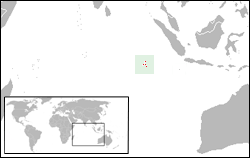William Keeling

Captain William Keeling (1578–1620), of the East India Company, was a British sea captain. He commanded the Susanna on the second East India Company voyage in 1604. During this voyage his crew was reduced to fourteen men and one of the ships vanished. On the third voyage he commanded the Red Dragon and the Hector in 1607. He discovered the Cocos (Keeling) Islands in 1609 as he was going home from Banda to England.
On his return, King James I appointed Keeling a Groom of the Chamber, and in c. 1618 he was named Captain of Cowes Castle on the Isle of Wight, where he died in 1620.[1]
A fragment of Keeling's diary survives, in which he details his crew's shipboard performances of Shakespeare's Hamlet (off the coast of Sierra Leone, 5 September 1607, and at Socotra, 31 March 1608)[1] and Richard II (Sierra Leone, 30 September 1607).[1] For a time after its discovery, the fragment was suspected of being a forgery, but is now generally accepted as genuine.[2] These are the first recorded amateur performances of any Shakespeare plays.[1]
